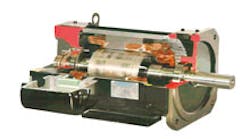Definite and Special-Purpose Motors
To apply a definite-purpose motor for a duty other than that for which it was intended must be carefully considered. Modifications can be made easily and inexpensively. Other modifications may require special tooling, increasing cost. The electrical characteristics of the motor must be checked very closely against the load. Testing the motor with the application is recommended.
Instrument motors: Instrument motor definitions vary with users and manufacturers of motors. Generally, an instrument motor is a precision motor with fractional or subfractional horsepower ratings. Sizes range from 1/2 to 3/4hp units.
Gearmotors: A gearmotor consists of a gear-reduction unit with an integral or flange-mounted rotor. The main advantage of a gearmotor is that the driving shaft may be coupled directly to the driven shaft. Belts, pulleys, chains, or additional gearing to step down motor speed are not needed. Also, coupling or belting of a motor to a separate speed-reducer unit is eliminated.
Torque requirements: Starting and running torques are considered separately because starting characteristics of the motor and gearing differ. Applications needing high breakaway torques require careful selection of the motor because split-phase, polyphase, capacitor-start, and brush-type motors have large starting torques.
Applications with high inertias should be analyzed by the gearmotor manufacturer. This problem is critical with self-locking right-angle gearmotors. Since rotor and load are rigidly connected by the gear train, both must stop in the same time. In severe cases, momentary power failure may be all that is necessary for a high inertial load to destroy the gear train.
Overhung loads are applied to the output shaft of the gearmotor whenever the gearmotor is connected to the applications requiring cams, belts, or gearing. Applications requiring cams, hoisting drums, or switches at the output shaft can also cause very high overhung loads on gearhead bearings.
It is inherent with gearmotors that overhung load capacity decreases as the delivered torque increases. This reduction is caused by internal gear-reduction forces. In small fhp gearheads, reducer bearings may be fully loaded by the reactions resulting from rated torque. Under these conditions, no additional overhung load may be placed on the output shaft.
When the overhung-load capacity of a gearmotor is too small, it may be possible to obtain oversize shafts and bearings. A third or outboard bearing is sometimes used to support the end of the driveshaft. However, it is extremely important that this bearing is properly aligned to prevent excessive shaft and bearing loads. Thrust loads are most severe with vertical-shaft units and gearmotors driving a lead screw or axial actuating device. It is often less expensive to specify a heavy-duty unit rather than extensively modify a normal-duty unit when loads are excessive.
Toothless motors: Some motors can be made with toothless armatures, thanks to powerful modern magnets. Coils are wound and assembled outside the motor, then inserted and secured as a unit in the armature.
Toothless construction provides more space for armature coils and provides higher current ratings. Iron losses are cut by 50%, and armature inductance approaches that for cup motors. Toothless motors do not cog at low speed. And because coil insertion is easier, motor diameters can be smaller.
In toothless motors that use ceramic magnets, flux density in the air gap is much lower than in conventional motors. The low density results from the large air gap, an inherent characteristic of toothless construction.
Toothless motors equipped with rare-earth magnets, however, operate at high flux densities. These motors contain magnets that are about the same length as the air gap. With this relationship, rare-earth magnets operate at flux levels that are close to the magnet's maximum energy product.
